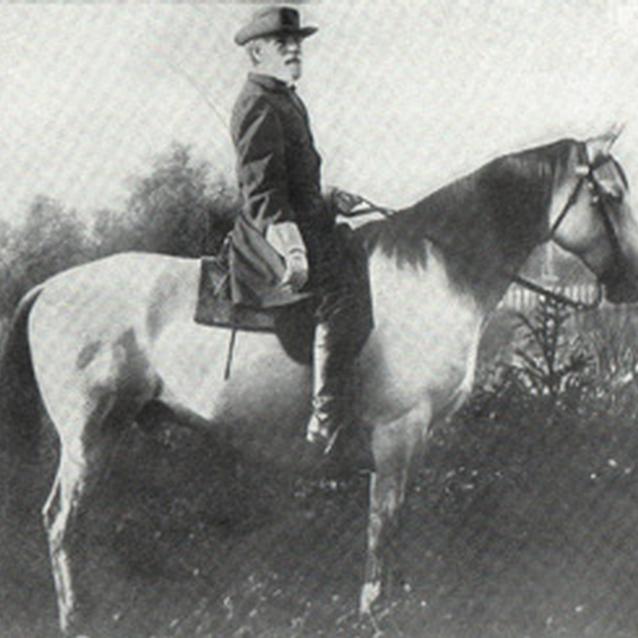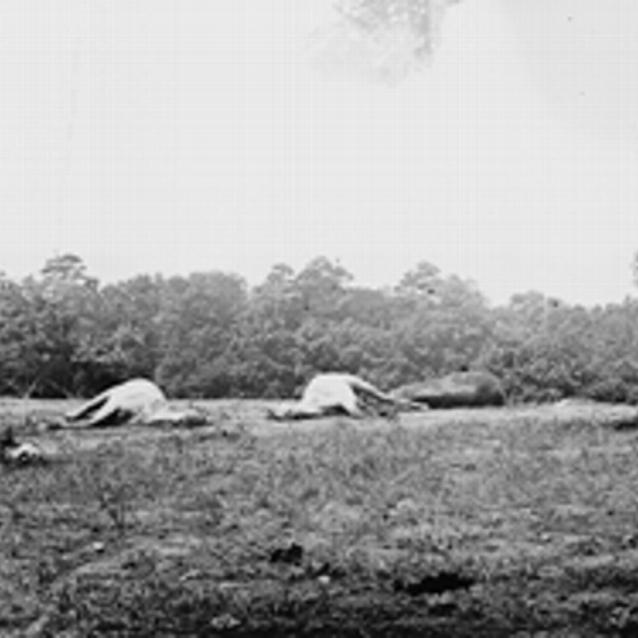For a Civil War general, a horse could be much more than just transportation and a better view of the battlefield. A brave, dignified mount could be a symbol of authority and inspire the troops almost as much as the man in the saddle. Because of the harsh conditions, far movements, and long hours, any horse that dutifully served its officer earned a great deal of respect and admiration.
"Such endurance I have never seen in horse flesh. We had no horse at Hd. Qrs. That could match him. I never saw him show a sign of fatigue." Henry Kyd Douglas describing "Stonewall" Jackson's horse
On the Backs of Friends

Library of Congress
Quite often, men would dedicate a great deal of personal attention to their animals, treating them more like friends. Confederate Gen. Robert E. Lee was such a man, caring deeply for his favorite horse, Traveler. After the war, when an artist told Lee that he wanted to paint a portrait of the large gray, Lee replied with praise for the proud and faithful mount.
"Such a picture could inspire a poet, whose genius could then depict his worth and describe his endurance of toil, hunger, thirst, heat and cold, and the dangers and sufferings through which he has passed. He could dilate upon his sagacity and affection and his invariable response to every wish of his rider. He might even imagine his thoughts through the long night marches and days of battle through which he has passed."
The favorite horse of Union Gen. George B. McClellan was Dan, or Daniel Webster, named for the famous Massachusetts Senator and eloquent orator, whom he admired. The horse was a tall, pure-bred, dark bay; his appearance as striking as his master's. Dan was tireless on campaign, and repeatedly bore the General into combat. Since the horse was so fast and powerful, McClellan's staff officers named him "that Devil Dan" because they could not keep pace on their slower mounts.
In April 1861, Col. Thomas J. Jackson, later known as "Stonewall", took command of the Confederate forces at Harpers Ferry, Virginia. A few days later his men seized an eastbound train, carrying cattle and horses. Jackson had no regular mount so he and his quartermaster selected two horses--a large sorrel gelding and a smaller sorrel. Jackson planned to give his wife, Anna, the small horse he named Fancy.
Within a day, however, Jackson found the larger animal to be uneven in gait and difficult to control. He much preferred the smooth gait, even temper, and endurance of "Little Sorrel," who also proved to be steady under fire on the battlefield. Henry Kyd Douglas described Jackson's mount as "a remarkable little horse. Such endurance I have never seen in horse flesh. We had no horse at Hd. Qrs. That could match him. I never saw him show a sign of fatigue."
Death on Four Legs

Library of Congress
Thousands of horses and mules were killed over the month of the Maryland Campaign. Many were lost in combat; shot out from under officers and cavalry troops. Artillery horses were often struck down when their batteries came under enemy fire. In one instance, eighty out of one battery's eighty-eight horses were killed in a single battle.
Like their human counterparts, horses also faced the problem of disease. One condition that plagued the horses of both armies was known as "greasy heel," a skin disease. Col. Rufus Ingalls, McClellan's chief quartermaster called the epidemic, "A most powerful and destructive disease... which put nearly 4,000 animals out of service." Other diseases, overuse, injuries, and combat could also make the lives of horses short.
No matter how they died, the bodies of the dead horses had to be disposed of. Almost every account of a battlefield mentions the sight and stench of rotting horses strewn across hills and roads. Already overburdened with human casualties, both armies resorted to the practice of burning the bodies of the noble animals that had sacrificed so much in this war.
"The number of dead horses was high. They lay, like the men, in all attitudes. One beautiful milk-white animal had died in so graceful a position that I wished for its photograph... Until you got to it, it was hard to believe the horse was dead."
~ Union Gen. Alpheus Williams, September 22nd, 1862
Part of a series of articles titled The Burden of Beasts.
Previous: Fast and Flexible
Next: Man's Best Friend
Tags
Last updated: February 4, 2015
